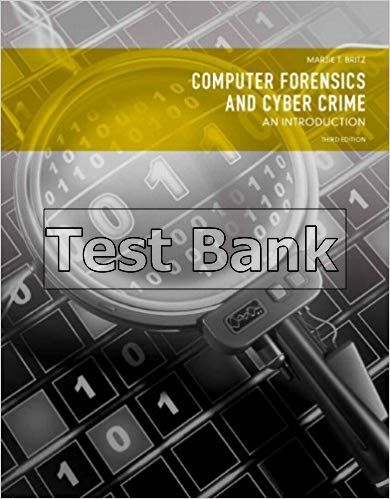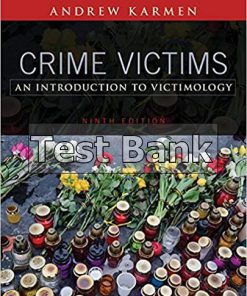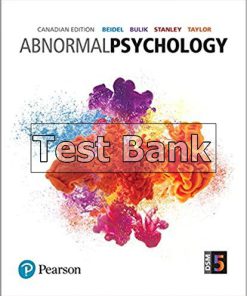Computer Forensics and Cyber Crime An Introduction 3rd Edition Britz Test Bank
$26.50$50.00 (-47%)
Computer Forensics and Cyber Crime An Introduction 3rd Edition Britz Test Bank.
You may also like
Computer Forensics and Cyber Crime An Introduction 3rd Edition Britz Test Bank

Product details:
- ISBN-10 : 0132677717
- ISBN-13 : 978-0132677714
- Author: Dr. Marjie T. Britz
The leading introduction to computer crime and forensicsis now fully updated to reflect today’s newest attacks, laws, and investigatory best practices. Packed with new case studies, examples, and statistics, Computer Forensics and Cyber Crime, Third Edition adds up-to-the-minute coverage of smartphones, cloud computing, GPS, Mac OS X, Linux, Stuxnet, cyberbullying, cyberterrorism, search and seizure, online gambling, and much more. Covers all forms of modern and traditional computer crime, defines all relevant terms, and explains all technical and legal concepts in plain English, so students can succeed even if they have no technical, legal, or investigatory background.
Table contents:
- Chapter 1 INTRODUCTION AND OVERVIEW OF COMPUTER FORENSICS AND CYBERCRIME
- I. Introduction
- II. Cyberspace and Criminal Behavior
- III. Clarification of Terms
- IV. Traditional Problems Associated with Computer Crime
- a. Physicality and Jurisdictional Concerns
- b. Perceived Insignificance, Stereotypes, and Incompetence
- c. Prosecutorial Reluctance
- d. Lack of Reporting
- e. Lack of Resources
- f. Jurisprudential Inconsistency
- V. Extent of the Problem
- VI. The Emergence of e-Cash: A New Problem for Law Enforcement
- a. Prepaid Cards
- b. Stored Value Cards
- c. Mobile Payments
- d. Internet Payment Services
- e. Digital Precious Metals
- VII. Conclusions
- Discussion Questions
- Recommended Reading
- Web Resources
- Endnotes
- Chapter 2 COMPUTER TERMINOLOGY AND HISTORY
- I. A Brief History of Computers
- II. Computer Language
- a. Understanding Data
- III. Computer Hardware
- a. Input Devices
- b. Output Devices
- c. Hard Drives and Other Mass Storage Devices
- IV. Computer Software
- a. Boot Sequence
- b. Operating System
- V. Beyond DOS: Contemporary Operating Systems
- a. Microsoft Windows
- b. Macintosh
- c. UNIX
- d. LINUX
- e. Smart Phones
- VI. Application Software
- VII. A Brief History of the Internet
- VIII. Network Language
- a. Commonly Used Terms
- IX. Realms of the Cyberworld
- X. Data Bandwith Transfer Rates
- XI. Categorizing Internet Communication
- a. World Wide Web
- b. Newsgroups/Bulletin Boards (Usenet Groups)
- c. Internet Relay Chat
- XII. Future Issues and Conclusions
- Discussion Questions
- Recommended Reading
- Web Resources
- Endnotes
- Chapter 3 TRADITIONAL COMPUTER CRIME: EARLY HACKERS AND THEFT OF COMPONENTS
- I. Introduction
- II. Traditional Problems
- III. Recognizing and Defining Computer Crime
- IV. Three Incidents
- V. Phreakers: Yesterday’s Hackers
- a. What Is Phreaking?
- b. The War on Phreaking
- VI. Hacking
- a. Defining Hacking
- b. Evolution in the Hacking Community
- c. Contemporary Motivation
- d. Hierarchy of Contemporary Cybercriminals
- VII. Computers as Commodities
- a. Hardware
- VIII. Theft of Intellectual Property
- a. Software
- b. Film Piracy
- XI. Conclusions
- Discussion Questions
- Recommended Reading
- Web Resources
- Endnotes
- Chapter 4 CONTEMPORARY COMPUTER CRIME
- I. Web-Based Criminal Activity
- a. Interference with Lawful Use of Computers
- II. Malware
- a. Viruses and Worms
- b. DoS and DDoS Attacks
- c. Botnets and Zombie Armies
- d. Spam
- e. Ransomware and the Kidnapping of Information
- III. Theft of Information, Data Manipulation, and Web Encroachment
- a. Traditional Methods of Proprietary Information Theft
- b. Trade Secrets and Copyrights
- c. Political Espionage
- IV. Terrorism
- a. Cyberterrorism
- V. Neotraditional Crime: Old Wine in New Bottles
- a. Dissemination of Contraband or Offensive Materials
- b. Threatening and Harassing Communications
- c. Online Fraud
- d. e-Fencing
- e. Fraudulent Instruments
- VI. Ancillary Crimes
- a. Money Laundering
- VII. Conclusions
- Discussion Questions
- Recommended Reading
- Web Resources
- Endnotes
- Chapter 5 IDENTITY THEFT AND IDENTITY FRAUD
- I. Introduction
- II. Typologies of Identity Theft/Fraud
- a. Assumption of Identity
- b. Theft for Employment and/or Border Entry
- c. Criminal Record Identity Theft/Fraud
- d. Virtual Identity Theft/Fraud
- e. Credit Identity Theft/Fraud
- III. Prevalence and Victimology
- a. Victims and the Costs Associated with Victimization
- b. Future Increases
- IV. Physical Methods of Identity Theft
- a. Mail Theft
- b. Dumpster Diving
- c. Theft of Computers
- d. Bag Operations
- e. Child Identity Theft
- f. Insiders
- g. Fraudulent or Fictitious Companies
- h. Card Skimming, ATM Manipulation, and Fraudulent Machines
- V. Virtual or Internet-Facilitated Methods
- a. Phishing
- b. Spyware and Crimeware
- c. Keyloggers and Password Stealers
- d. Trojans
- VI. Crimes Facilitated by Identity Theft/Fraud
- a. Insurance and Loan Fraud
- b. Immigration Fraud and Border Crossings
- VII. Conclusions and Recommendations
- Discussion Questions
- Recommended Reading
- Web Resources
- Endnotes
- Chapter 6 TERRORISM AND ORGANIZED CRIME
- I. Terrorism
- a. Defining Terrorism
- b. Classification Through Motivation
- c. Roots of Contemporary Terrorism
- d. Terrorism as a Stage
- e. Cyberterrorism as a Concept
- II. Terror Online
- a. Propaganda, Information Dissemination, Recruiting, and Fundraising
- b. Training
- c. Research and Planning
- d. Communication
- e. Attack Mechanism
- III. Terrorism and Crime
- a. Criminal Activities
- b. Criminalizing Terrorist Acts
- c. Government Efforts
- d. Conclusions
- IV. Organized Crime
- a. Defining Organized Crime
- b. Distinguishing Organized Crime from Cybergangs
- V. Organized Crime and Technology
- a. Extortion
- b. Cargo Heists and Armed Robbery
- c. Fraud
- d. Money Laundering
- e. The Sex Trade
- f. Confidence Scams
- g. Fencing of Stolen Property
- h. Data Piracy and Counterfeit Goods
- i. Human Smuggling
- VI. Confronting Contemporary Organized Crime
- VII. The Intersection of Organized Crime and Terrorism
- Discussion Questions
- Recommended Reading
- Web Resources
- Endnotes
- Chapter 7 AVENUES FOR PROSECUTION AND GOVERNMENT EFFORTS
- I. Introduction
- II. Traditional Statutes
- III. The Evolution of Computer-Specific Statutes
- a. Computer Fraud and Abuse Act of 1986
- b. National Information Infrastructure Protection Act of 1996 (NIIPA)
- IV. Evolving Child Pornography Statutes
- V. Identity Theft and Financial Privacy Statutes
- a. Identity Theft and Assumption Deterrence Act of 1998
- b. The Financial Modernization Act of 1999
- c. Fair and Accurate Credit Transactions Act (FACTA) 2003
- d. Identity Theft Penalty Enhancement Act of 2004
- e. Identity Theft Enforcement and Restitution Act of 2008
- f. Additional Efforts to Protect Personal Information
- VI. Federally Funded Initiatives and Collaborations
- VII. Law Enforcement Operations and Tools in the United States
- a. Packet Sniffers and Key Loggers
- b. Data Mining
- c. Collaborations and Professional Associations
- VIII. International Efforts
- a. OECD and the Select Committee of Experts on Computer-Related Crime of the Council of Europe
- b. Council of Europe’s (CoE) Cybercrime Conventions
- IX. Conclusions
- Discussion Questions
- Recommended Reading
- Web Resources
- Endnotes
- Chapter 8 APPLYING THE FIRST AMENDMENT TO COMPUTER-RELATED CRIME
- I. Introduction and General Principles
- II. Obscenity in General
- III. Traditional Notions of Decency
- IV. Emerging Statutes and the Availability of Obscene Material to Children
- V. Traditional Attempts to Criminalize Child Pornography
- VI. Applying Case Law to Traditional Child Pornography Statutes
- a. New York v. Ferber
- b. Osborne v. Ohio
- VII. Technology-Specific Legislation—Contention in the Courts
- a. Child Pornography Prevention Act
- b. Ashcroft v. Free Speech Coalition
- c. Prosecutorial Remedies and Other Tools to End the Exploitation of Children Today Act (PROTECT)
- d. U.S. v. Williams
- VIII. Internet Gambling
- a. Unlawful Internet Gambling Enforcement Act of 2006 (UIGEA)
- b. Case law on Internet Gaming Statutes
- c. Lack of International Cooperation and the WTO
- IX. Future Issues and Conclusions
- Discussion Questions
- Recommended Reading
- Web Resources
- Endnotes
- Chapter 9 THE FOURTH AMENDMENT AND OTHER LEGAL ISSUES
- I. The Fourth Amendment
- a. Probable Cause
- b. Reasonable Suspicion
- II. Warranted Searches and Computers
- a. Particularity
- b. Seizure of Evidence
- c. Third-Party Origination
- d. Other Arguments Used in Warranted Searches
- III. Warrantless Searches
- a. Consent
- b. Exigent Circumstances and Emergency Situations
- c. Incident to Arrest
- d. Plain View
- e. Border Searches
- f. Other Warrantless Searches
- IV. Exclusionary Rule
- V. Electronic Surveillance and the Right to Privacy
- a. Types of Recognized Privacy
- VI. Private versus Public Sector Searches
- VII. Application of Ortega to E-mail: The Cases of Simons and Monroe
- VII. The Electronic Communications Privacy Act and The Privacy Protection Act of 1980
- a. Electronic Communications Privacy Act of 1986
- b. Three Titles under ECPA
- c. Privacy Protection Act
- d. Defining Interception under ECPA and the PPA
- e. Communications Assistance for Law Enforcement Act
- f. Challenges to the CALEA
- g. Applying the Wiretap Act to E-mail Interceptions—U.S. v. Councilman
- VIII. The Patriot Act
- a. Enhanced Presidential Authority
- b. Electronic Surveillance and Criminal Investigations
- c. National Security Letters and Other Fourth Amendment Issues
- IX. Other Questions Regarding Privacy
- a. Peer-to-Peer or File sharing
- b. Internet Service Provider Subscriber Records
- c. Web sites
- d. Cell phones
- X. Other Legal Considerations
- a. Vicinage
- b. Undercover Techniques
- c. Sentencing Guidelines
- XI. Conclusions
- Discussion Questions
- Recommended Reading
- Web Resources
- Endnotes
- Chapter 10 COMPUTER FORENSICS: TERMINOLOGY AND REQUIREMENTS
- I. Computer Forensics—An Emerging Discipline
- II. Traditional Problems in Computer Investigations
- a. Inadequate Resources
- b. Lack of Communication and Cooperation among Agencies
- c. Over-reliance on Automated Programs and Self-proclaimed Experts
- d. Lack of Reporting
- e. Evidence Corruption
- IV. Disk Structure and Digital Evidence
- a. Disk Structure and Data Storage
- b. Partition Table
- c. File Systems
- c. Firmware—Operating Instructions
- e. Data Integrity
- V. Developing Computer Forensic Science Capabilities
- VI. Minimum Housing Requirements
- VII. Minimum Hardware Requirements
- VIII. Minimum Software Requirements
- a. Data Preservation, Duplication, and Verification Tools
- b. Data Recovery/Extraction Utilities
- c. Data Analysis Software
- d. Reporting Software
- e. Miscellaneous Software
- IX. A Sampling of Popular Forensic Software
- a. Guidance Software
- b. Access Data
- c. Other Forensic Utilities
- X. Conclusions
- Discussion Questions
- Recommended Reading
- Web Resources
- Endnotes
- Chapter 11 SEARCHING AND SEIZING COMPUTER-RELATED EVIDENCE
- I. Traditional Problems Associated with Finding Digital Evidence
- II. Pre-search Activities
- a. Warrant Preparation and Application
- b. Plan Preparation and Personnel Gathering
- c. Preparing a Toolkit
- d. Traditional Equipment
- e. Computer-Specific Equipment and Materials
- III. On-scene Activities
- a. Knock, Notice, and Document
- b. Securing the Crime Scene
- c. Determining the Need for Additional Assistance
- d. Scene Processing
- e. Locating Evidence
- f. Seizure and Documentation of Evidence
- g. Bagging and Tagging
- h. Interviewing Witnesses
- i. Scene Departure and Transportation of Evidence to Lab
- IV. Conclusions
- Discussion Questions
- Recommended Reading
- Web Resources
- Endnotes
- Chapter 12 PROCESSING OF EVIDENCE AND REPORT PREPARATION
- I. Aspects of Data Analysis
- a. Establish Forensically Sterile Conditions
- b. Ensure Legitimacy and Capabilities of Analysis Tools
- c. Physical Examination
- d. Creation and Verification of Image
- e. Jumping the CMOS Password
- f. Short-Circuiting the Chip
- g. Pulling the Battery
- h. Recovering Passwords
- i. Image Verification
- j. Logical Examination
- k. Restoration of Files
- l. Listing of Files
- m. Examine Unallocated Space for Data Remnants
- n. Unlocking Files
- q. Examination of User Data Files
- r. Piping of Evidence
- s. Examination of Executable Programs
- t. Evidence from Internet Activity
- II. Non-Windows Operating Systems
- a. Macintosh Operating System
- b. Linux/Unix Operating Systems
- III. Smart Phones and GPS Forensics
- a. Smartphones
- IV. A Sample of Popular Products
- V. Naviation Sysstems
- VI. Report Preparation and Final Documentation
- VII. Conclusions
- Discussion Questions
- Recommended Reading
- Web Resources
- Endnotes
- Chapter 13 CONCLUSIONS AND FUTURE ISSUES
- I. Traditional Problems and Recommendations
- a. Establishing Technology-Neutral Legislation
- b. Establishing Accountability for Internet Users
- c. Increasing Public Awareness and Research Capabilities
- d. Increasing Interagency and Intradepartmental Cooperation
- e. Developing Relationships between Investigative Agencies and the Private Sector
- f. Developing International Cooperation
- g. Standardization of Accreditation or Expertise
- h. Miscellaneous
- II. Additional Approaches to Internet Crime
- III. Future Trends and Emerging Concerns
- a. Wireless Communications
- b. Data Hiding: Remote Storage, Encryption, and the Like
- c. Governing Decency and Virtual Pornography
- d. Data Mining and Increased Interoperability
- IV. Conclusions
- Discussion Questions
- Web Resources
- Endnotes
- Bibliography
- Index
People also search:
computer forensics and cyber crime an introduction 3rd edition pdf
computer forensics and cyber crime an introduction 3rd edition
what is computer forensics in cyber security
types of computer forensics
computer forensics examples












